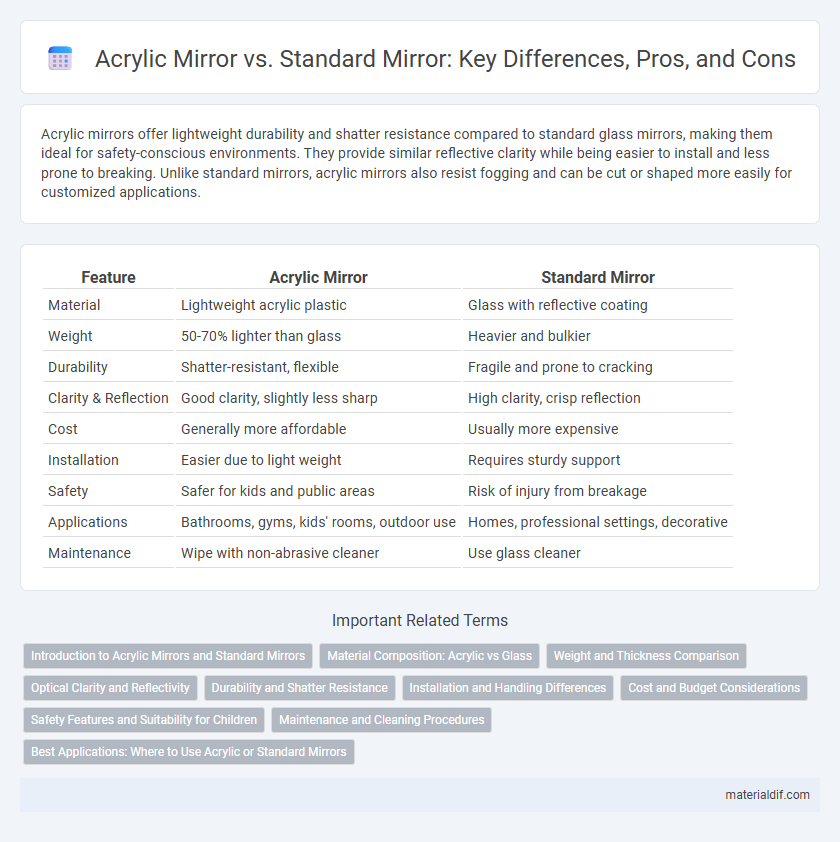Acrylic mirrors offer lightweight durability and shatter resistance compared to standard glass mirrors, making them ideal for safety-conscious environments. They provide similar reflective clarity while being easier to install and less prone to breaking. Unlike standard mirrors, acrylic mirrors also resist fogging and can be cut or shaped more easily for customized applications.
Table of Comparison
| Feature | Acrylic Mirror | Standard Mirror |
|---|---|---|
| Material | Lightweight acrylic plastic | Glass with reflective coating |
| Weight | 50-70% lighter than glass | Heavier and bulkier |
| Durability | Shatter-resistant, flexible | Fragile and prone to cracking |
| Clarity & Reflection | Good clarity, slightly less sharp | High clarity, crisp reflection |
| Cost | Generally more affordable | Usually more expensive |
| Installation | Easier due to light weight | Requires sturdy support |
| Safety | Safer for kids and public areas | Risk of injury from breakage |
| Applications | Bathrooms, gyms, kids' rooms, outdoor use | Homes, professional settings, decorative |
| Maintenance | Wipe with non-abrasive cleaner | Use glass cleaner |
Introduction to Acrylic Mirrors and Standard Mirrors
Acrylic mirrors offer lightweight, shatter-resistant alternatives to traditional glass mirrors, making them ideal for safety-focused environments. Standard mirrors, typically made from glass with a reflective silver or aluminum backing, provide high clarity and durability suited for everyday use. The choice between acrylic and standard mirrors depends on factors such as impact resistance, weight, and application setting.
Material Composition: Acrylic vs Glass
Acrylic mirrors are made from lightweight polymethyl methacrylate (PMMA), offering shatter-resistant and flexible properties compared to the brittle and heavier glass used in standard mirrors. The acrylic material allows for easier cutting and shaping without compromising clarity, whereas glass mirrors provide superior scratch resistance and traditional reflective quality due to their silica-based composition. Differences in material composition affect durability, weight, and installation requirements, making acrylic mirrors ideal for safety-sensitive environments while glass mirrors excel in high-clarity applications.
Weight and Thickness Comparison
Acrylic mirrors weigh significantly less than standard glass mirrors, making them ideal for applications requiring lightweight materials. The thickness of acrylic mirrors typically ranges from 1/8 inch to 1/4 inch, offering flexibility without sacrificing clarity, whereas standard mirrors are usually thicker and heavier to maintain durability. This weight and thickness disparity enhances ease of installation and reduces strain on mounting surfaces for acrylic mirrors.
Optical Clarity and Reflectivity
Acrylic mirrors offer superior optical clarity with up to 92% light reflectivity, providing a distortion-free reflection compared to standard glass mirrors that typically reflect around 85-88%. The lightweight, shatter-resistant nature of acrylic ensures consistent reflectivity without the risk of cracking or fogging, enhancing durability in various applications. These properties make acrylic mirrors ideal for environments requiring high visual accuracy and safety.
Durability and Shatter Resistance
Acrylic mirrors offer superior durability compared to standard glass mirrors, as they are made from impact-resistant plastic that withstands drops and knocks without cracking. Their shatter-resistant properties make them ideal for environments prone to accidents, such as homes with children or busy commercial spaces. Unlike standard mirrors that can shatter into sharp shards, acrylic mirrors break into large, less dangerous pieces, enhancing safety and longevity.
Installation and Handling Differences
Acrylic mirrors weigh significantly less than standard glass mirrors, simplifying installation and reducing the risk of wall damage or injury. Their flexibility allows for easy cutting and shaping onsite, unlike rigid glass mirrors which require professional tools and handling. Acrylic's shatter-resistant properties increase safety during handling, making it a preferred choice for environments where breakage is a concern.
Cost and Budget Considerations
Acrylic mirrors typically offer a more budget-friendly option compared to standard glass mirrors, often costing 30-50% less depending on size and thickness. They provide substantial savings in shipping and installation costs due to their lightweight and shatter-resistant nature, making them ideal for large projects or budget-conscious renovations. While acrylic mirrors may have a shorter lifespan and higher susceptibility to scratches than traditional glass, the initial cost benefits make them a practical choice for many residential and commercial applications.
Safety Features and Suitability for Children
Acrylic mirrors offer enhanced safety features compared to standard glass mirrors due to their shatterproof and lightweight properties, significantly reducing the risk of injury from breakage. Their impact resistance makes acrylic mirrors highly suitable for environments with children, such as playrooms and schools, where safety is a priority. Unlike glass mirrors, acrylic mirrors maintain clarity and durability while providing a safer alternative for child-friendly spaces.
Maintenance and Cleaning Procedures
Acrylic mirrors require gentle cleaning with a soft cloth and mild soap to prevent scratching, unlike standard glass mirrors that can tolerate stronger cleaners and scrubbing. Avoid abrasive materials or ammonia-based products on acrylic surfaces as they can cause permanent damage. Regular dusting and immediate cleaning of smudges help maintain the clarity and longevity of acrylic mirrors compared to the more durable standard mirrors.
Best Applications: Where to Use Acrylic or Standard Mirrors
Acrylic mirrors excel in environments requiring lightweight, shatter-resistant materials, making them ideal for children's rooms, gyms, and outdoor spaces. Standard glass mirrors offer superior optical clarity and scratch resistance, best suited for bathrooms, dressing rooms, and decorative wall installations. Choosing between acrylic and standard mirrors depends on the balance of durability, safety, and visual quality needed for the specific application.
Acrylic Mirror vs Standard Mirror Infographic

 materialdif.com
materialdif.com